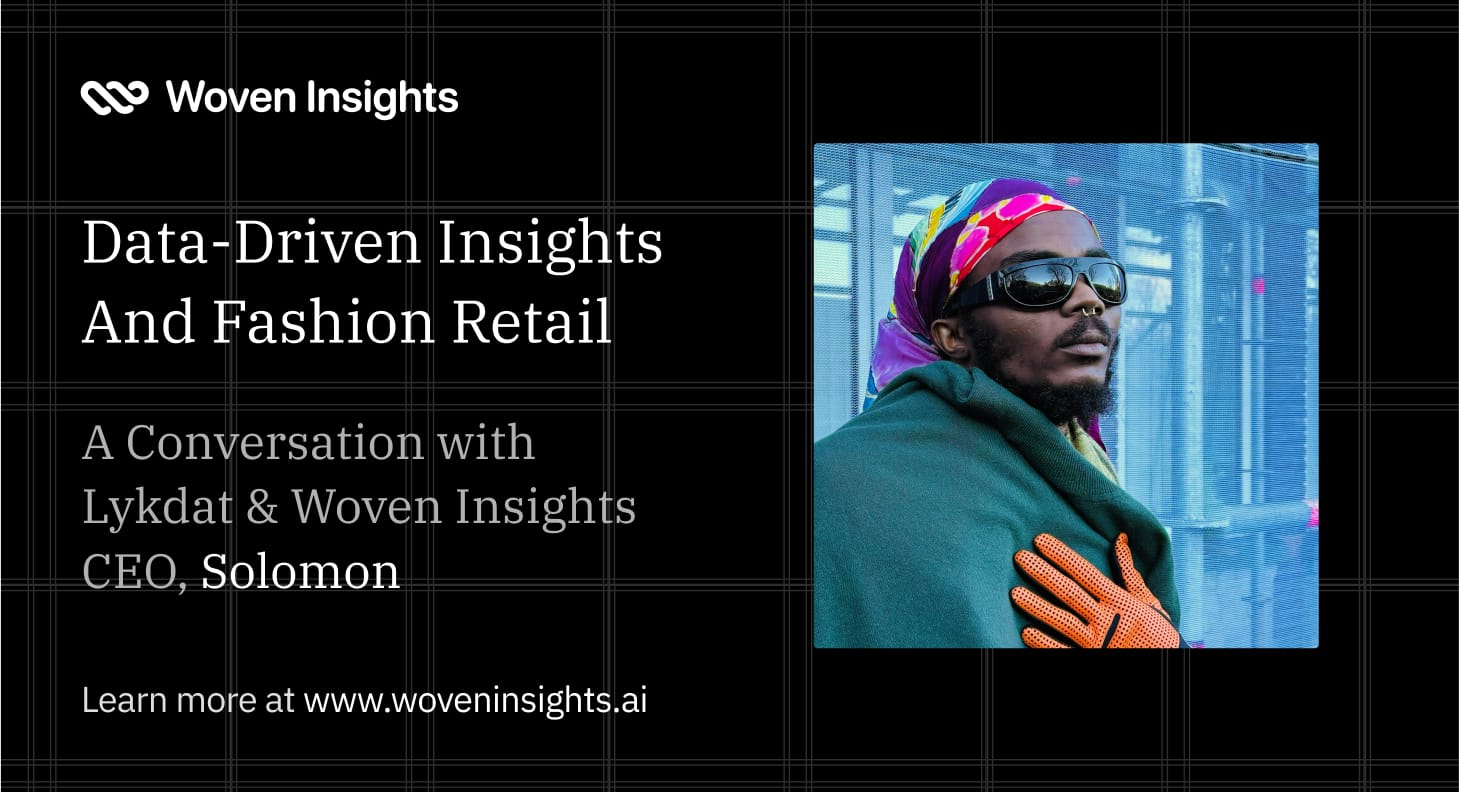How AI-Powered Insights Are Transforming Fashion Ecommerce - Thoughts from Lykdat & Woven Insights CEO, Solomon
CEO of Lykdat & Woven Insights, Solomon, sheds light on how AI is empowering fashion businesses in making profitable design and retail decisions.

The fashion industry is evolving faster than ever. With trends shifting daily and consumer preferences growing more nuanced, brands and retailers face immense pressure to stay ahead. Manual market research and gut-driven decisions are no longer enough.
To avoid falling behind, leading fashion businesses now use real-time market trends, consumer sentiment analysis, and strategic data-driven decision-making tools.
To shed light on this transformation, we spoke with Solomon; software engineer, creative artist and fashion aficionado. He is the Co-founder and CEO of Lykdat Tech, makers of the most popular fashion image search platform on the internet.
You want it? You’ve got it! 😉 pic.twitter.com/kb5ZHre1mE
— Lykdat (@lykdatApp) February 21, 2023
Solomon is also the co-founder and CEO of Woven Insights, a business intelligence platform helping fashion brands and apparel manufacturers to harness the power of AI-driven retail market and consumer insights.
In this article, Solomon shares how AI is revolutionizing fashion retail and why data is the new competitive advantage for brands in 2025 and beyond.
The AI Revolution in Fashion Ecommerce
In today’s highly competitive ecommerce landscape, fashion brands face challenges such as:
- Keeping up with rapidly changing trends
- Understanding what customers want in real time
- Making it easy for shoppers to find what they want, even when they don't have the perfect words to describe them.
- Staying competitive with pricing & product positioning
- Avoiding inventory mismanagement (overstocking vs. stockouts)
AI is no longer some tech buzzword - it’s fast becoming a daily necessity. For fashion businesses, AI unlocks unprecedented opportunities to decode market behavior and consumer sentiment. As Solomon explains:
“We’ve used AI long before ChatGPT. At Lykdat, computer vision powers our image search engine, helping shoppers find products visually. At Woven Insights, NLP analyzes thousands of reviews to detect quality issues, while machine learning forecasts trends.”
Key AI Applications in Fashion:
- Natural Language Processing (NLP):
- Scans product reviews and social media to gauge customer sentiment.
- Identifies recurring complaints (e.g., “fabric tears easily”) for quality control.
- Computer Vision:
- Powers visual search tools (like Lykdat’s platform) to help users discover products.
- Analyzes product images to detect dominant colors, patterns, and styles.
- Machine Learning:
- Predicts demand spikes by analyzing pricing trends and sell-out rates.
- Flags underperforming products before they impact revenue.
According to Solomon:
“There's a lot of manual work that can be eliminated by using a solution like Woven Insights. Instead of spending weeks tracking market trends manually, businesses get instant insights that help them move faster in launching collections and refining product development.”
Introducing Woven Insights
Woven Insights is basically an advanced data analytics and competitive intelligence solution helping fashion businesses find answers to pertinent questions about the market - at the click of a button.
Woven Insights focuses on two pillars: Market Insights and Consumer Insights. Here’s how they differ and why both matter:
Market Insights: Decoding the “What”
Market Insights answer critical questions about products and competition:
- Which colors dominate this season’s dresses?
- Are prices rising or falling for vegan leather bags?
- How quickly do certain styles sell out?
- How do competitors react to market trends?
“Market Insights help brands validate design choices and identify new opportunities for inventory strategies,” says Solomon. “If a competitor’s product sells out within hours at full price, that’s a signal of unmet demand.”
Popular Use Cases:
- Pricing Strategy: Track competitors’ discounts and adjust pricing dynamically.
- Trend Forecasting: Identify rising styles (e.g., oversized blazers) before they peak.
- Inventory Management: Predict replenishment needs based on historical sell-out rates.
Consumer Insights: Understanding the “Why”
Consumer Insights dive into the human side of data:
- What do customers love or hate about a product?
- Which features drive loyalty (e.g., comfort, price, fit)?
- How do cultural shifts impact purchasing behavior?
Popular Use Cases:
- Quality Control: Identify recurring complaints (e.g., “zipper breaks”) in real time.
- Product Development: Use positive feedback to double down on winning features.
- Brand Reputation: Uncover true brand perception based on customer feedback across product catalogs.
Solomon comments:
"Our Consumer Insights module has been serving arguably the biggest player in the apparel manufacturing industry for years now. We're doing a great job helping fashion brands and manufacturers understand their customers and the overall fashion market better - at an accessible price point."
The Tangible Impact of Data-Driven Decisions
Fashion brands using Woven Insights report transformative results:
- Significantly reduce market research time by automating data collection and analysis.
- About 20% reduction in returns after addressing quality issues flagged by AI.
- Up to 15% revenue growth by aligning collections with forecasted trends.
“Speed is everything in fashion,” says Solomon. “With AI, brands can cut decision-making time from weeks to hours.”
The Future of Fashion Ecommerce: Solomon’s Vision
Solomon is excited about Woven Insights’ evolving capabilities:
- AI Chatbots: A new chatbot acts as a “data concierge,” answering questions like, “What’s driving negative reviews for midi dresses?”
- Custom Widgets: Features tested in the chatbot (e.g., “Top Customer Pain Points”) are becoming standalone dashboard widgets.
- Global Expansion: Adding non-English review analysis to serve emerging markets.
“Our goal is to make fashion data as intuitive as checking the weather,” he says. “You shouldn’t need specialized training to use it.”
Advice For Fashion Businesses
In the interview, Solomon advised fashion businesses on how to better understand their market and customers through data. His key points were:
- There Are Many Data Options Available: Fashion businesses now have access to vast amounts of data, but they need to decide whether to stick to fashion experts, build their own data solutions, or use existing platforms like Woven Insights.
- Balance Cost vs. Value: Businesses should weigh the cost of collecting and analyzing data against the value they can extract from it. They should also weigh the ROI of DIY analytics vs. partnering with experts. Different options have different costs and advantages, so choosing the right one is crucial.
- Understand the Impact of Data: Some businesses don't fully realize how insights from data can transform their decision-making. Understanding the potential impact of data-driven decisions is key to making the most of available insights.
- Woven Insights Can Help: Solomon highlighted that Woven Insights not only provides standard insights but also helps businesses identify new areas where data can bring value, making it easier for them to leverage analytics in a way that is meaningful to them.
Conclusion
In a world where fashion trends are born and buried on TikTok, data is the ultimate competitive edge. Tools like Woven Insights are democratizing access to AI-driven analytics - helping brands of all sizes make smarter, faster decisions.
The message is clear: The future of fashion belongs to those who harness data.
